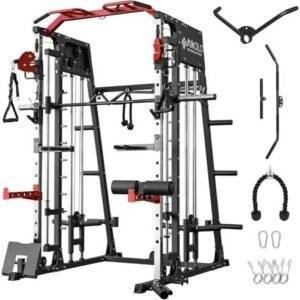Kettlebells have become increasingly popular in the world of fitness, known for their versatility and effectiveness in delivering a full-body workout. Whether you are a beginner or an experienced athlete, understanding how to properly use kettlebells can help enhance your strength, endurance, and overall physical performance. This guide will cover the basics of kettlebell training, including essential techniques, key exercises, and tips for incorporating them into your workout routine. By the end, you will have a clearer picture of how to use kettlebells effectively and safely to reach your fitness goals.
Table of Contents
- Choosing the Right Kettlebell for Your Fitness Goals
- Essential Kettlebell Exercises for Beginners
- Tips for Proper Form and Technique
- Creating a Balanced Kettlebell Workout Routine
- Final Thoughts
Choosing the Right Kettlebell for Your Fitness Goals
When selecting a kettlebell, it’s crucial to align your choice with your specific fitness objectives. Different weights and styles cater to various training goals, whether it’s strength building, endurance enhancement, or mobility improvement. For beginners, a lighter kettlebell (around 8-12 kg or 18-26 lbs) is often recommended to focus on form and technique before progressing to heavier weights. Intermediate and advanced users may opt for heavier options to continue challenging their muscles and advancing their skills.
Consider your current fitness level and the types of exercises you plan to incorporate into your routine. Kettlebell workouts can range from swings and snatches to Turkish get-ups and presses. Here are some factors to keep in mind when making your decision:
- Weight: Choose a bell that allows you to maintain proper form.
- Handle Size: Ensure the handle feels comfortable and allows for a secure grip.
- Material: Cast iron is common, but competition kettlebells have a uniform size regardless of weight.
| Goal | Recommended Weight |
|---|---|
| Beginner | 8-12 kg (18-26 lbs) |
| Intermediate | 12-16 kg (26-35 lbs) |
| Advanced | 16-24 kg (35-53 lbs) |
Essential Kettlebell Exercises for Beginners
Kettlebells are versatile fitness tools that can help beginners build strength, endurance, and flexibility. Starting with the right exercises is crucial for mastering the basic movements and ensuring safety. Here are a few essential exercises to incorporate into your routine:
- Kettlebell Swing: A powerful hip hinge movement that engages the entire body, focusing on the posterior chain.
- Goblet Squat: A squat variation that improves lower body strength while emphasizing proper form and alignment.
- Kettlebell Deadlift: A foundational exercise to develop back and leg strength, which prepares you for more complex movements.
- Kettlebell Press: A great upper body exercise that targets the shoulders and engages the core for stability.
To help visualize your workout progress, here’s a simple table illustrating the recommended sets and reps for each exercise:
| Exercise | Sets | Reps |
|---|---|---|
| Kettlebell Swing | 3 | 10-15 |
| Goblet Squat | 3 | 8-12 |
| Kettlebell Deadlift | 3 | 10-12 |
| Kettlebell Press | 3 | 8-10 |
Tips for Proper Form and Technique
When working with kettlebells, maintaining proper form is crucial for maximizing your workout benefits and minimizing the risk of injury. Here are some key points to remember:
- Engage your core: A strong core helps stabilize your body during movements, ensuring better control.
- Maintain a neutral spine: Always keep your back straight, avoiding rounding or arching, especially during lifts.
- Use your hips: Focus on driving the movement from your hips rather than using your arms, particularly for swings and cleans.
Understanding your body mechanics can further enhance your kettlebell routine. Incorporate these techniques:
- Keep your elbows close: For moves like the kettlebell snatch, keeping your elbows close to your body helps maintain balance.
- Find your grip: Use a grip that feels comfortable, ensuring your palms aren’t too sweaty to prevent slipping.
- Warm-up properly: Incorporate dynamic stretches to prepare your muscles and joints before your kettlebell workout.
| Movement | Focus Area | Common Mistake |
|---|---|---|
| Kettlebell Swing | Hip hinge | Using arms instead of hips |
| Kettlebell Goblet Squat | Form and depth | Leaning forward |
| Kettlebell Deadlift | Spine alignment | Rounding back |
Creating a Balanced Kettlebell Workout Routine
To create a balanced kettlebell workout routine, it’s essential to incorporate exercises that target all major muscle groups. This ensures comprehensive strength development and prevents imbalances that could lead to injury. Consider including the following elements in your routine:
- Push exercises: Such as kettlebell presses and floor presses.
- Pull exercises: Including kettlebell rows and swings.
- Leg workouts: Featuring goblet squats and lunges.
- Core strengthening: With exercises like Russian twists and windmills.
Additionally, varying the intensity and duration of your workouts can further enhance results. Aim to include both high-intensity interval training (HIIT) sessions and lower-intensity recovery days. A sample weekly plan might look like this:
| Day | Focus | Duration |
|---|---|---|
| Monday | Full Body Strength | 30 mins |
| Wednesday | HIIT | 20 mins |
| Friday | Core and Flexibility | 25 mins |
Final Thoughts
kettlebells offer a versatile and effective way to enhance your fitness routine. By understanding their unique design and incorporating various exercises, you can improve strength, flexibility, and endurance. Whether you are a beginner or an experienced athlete, kettlebells can be adapted to suit your needs and goals. Remember to focus on proper form and gradually increase intensity to avoid injury. With consistent practise and the right approach, kettlebells can help you achieve a healthier and more active lifestyle. Happy training!




